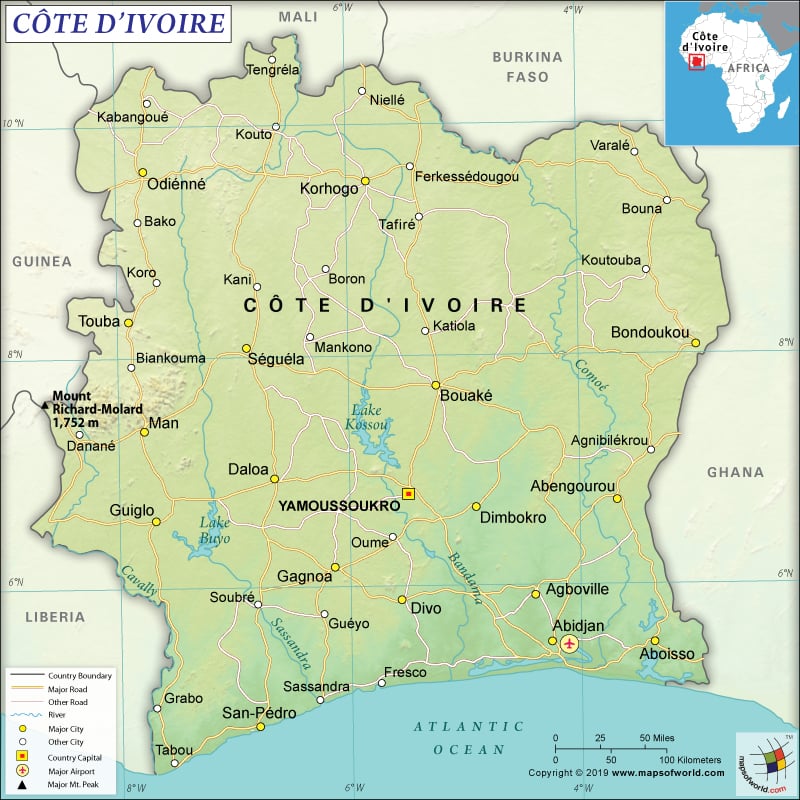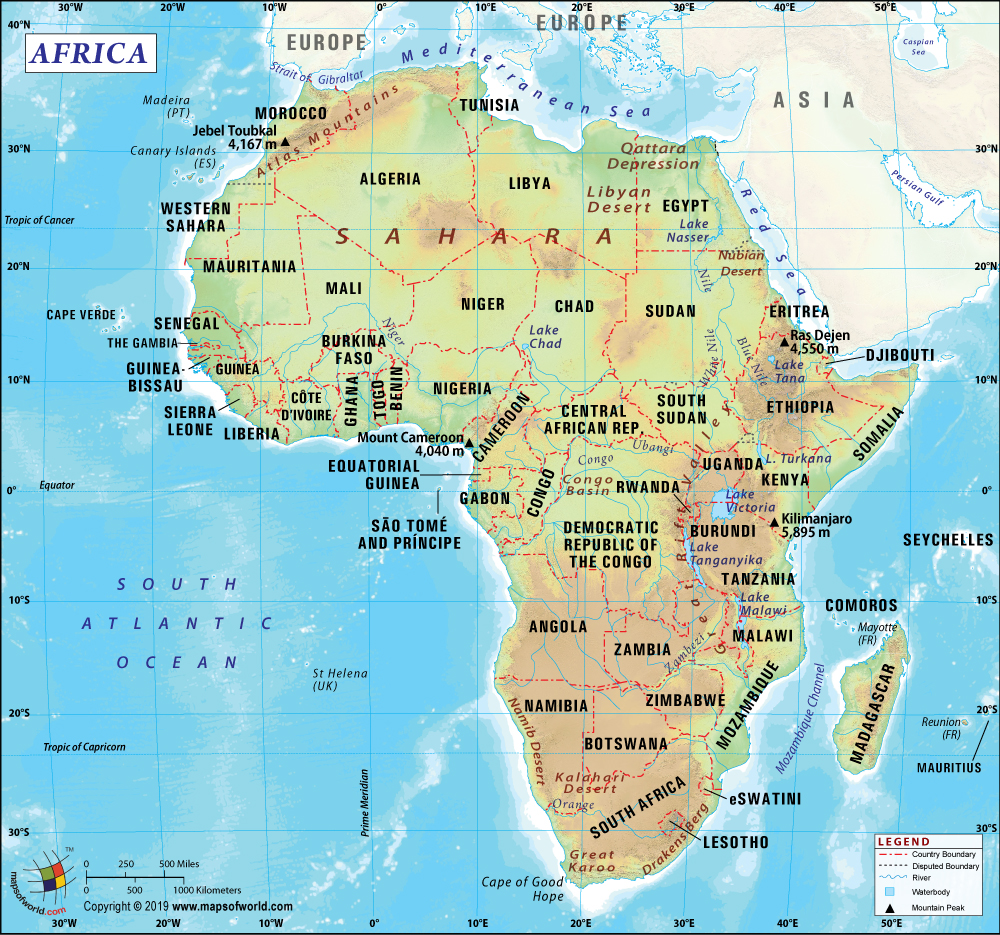What are the Key Facts of Côte d’Ivoire?

| Official Name | Republic of Côte d’Ivoire |
| Continent | Africa |
| Capital | Yamoussoukro |
| Largest City | Abidjan |
| Coordinates | 8.000000, -5.000000 |
| Area | 124,504 sq. mi ( 322,463 sq. km) |
| Land Boundaries | 2,149 mi ( 3,458 km) |
| Coastline | 370 mi ( 590 km) |
| Currency | West African CFA franc (XOF) |
| Neighboring Countries | Mali, Ghana, Burkina Faso, Guinea, Liberia |
| Population | 23,740,424 (2018 est. ) |
| Official Languages | French |
| Major Religion | Islam |
| National Day | 7 August (Independence Day) |
| National Anthem | “L’Abidjanaise” |
| Form of Government | Unitary presidential republic |
| President | Alassane Ouattara |
| Prime Minister | Amadou Gon Coulibaly |
| GDP per capita (PPP) | $ 4,199.7 (World Bank, 2018) |
| GDP per capita (nominal) | $ 1,715.5 (World Bank, 2018) |
| HDI | 0.492 (2017), Rank: 170 |
| Literacy Rate (%) | NA |
| Space Agency | NA |
| Military Expenditure Ranking | 83 (SIPRI, 2017) |
| No. of Olympic Medals | 3 (as of 2018) |
| Driving Side | right |
| Calling Code | +225 |
| Time Zone | UTC+0 (GMT) |
| Internet TLD | .ci |
Where is Côte d’Ivoire?
Côte d’Ivoire (also known as Ivory Coast) is a sub-Saharan country located in southern West Africa. It has a total land boundary of 3,458 km (2,149 mi). Ivory Coast shares its boundary with five neighboring countries: Guinea (816 km or 507 mi) to the northwest, Liberia (778 km or 483 mi) to the southwest, Ghana (720 km or 447 mi) to the east, Mali (599 km or 372 mi) to the north, and Burkina Faso (545 km or 339 mi) to the north. The country is also bounded by the Gulf of Guinea to the south.
What is the Geography of Côte d’Ivoire?
The country has a total area of 322,463 sq. km (124,504 sq. mi), out of which 318,003 sq. km (122,782 sq. mi) is land and just 4,460 sq. km (1,722 sq. mi) is water.
Cote d’Ivoire’s terrain is largely characterized by a large plateau. It rises gradually from sea level in the southern part of the country and continues rising in the north up to almost 500 m (1,640 ft). Coastal inland lagoons in the southeastern region of Cote d’Ivoire are another important feature of the country’s physical geography.
In addition, a dense tropical moist forest can be found in the southwest region of Ivory Coast. Eastern Guinean forests extend from the Sassandra River to the country’s south-central and southeast portions. The Western Guinean lowland forests extend from the Sassandra River to the west. The Guinean montane forests are located on the mountains in the Dix-Huit Montagnes region in western Cote d’Ivoire.
Moreover, the Guinean forest-savanna mosaic belt can be found in the transition zone of the interior savannas and coastal forests. They extend from east to west across the Ivory Coast’s middle. Northern region of the country is a part of the ecoregion called West Sudanian Savanna. This area consists of sandy soil and lots of vegetation, which decreases from south to north. Except for the mountains in the northeastern parts of Cote d’Ivoire, the landforms are generally flat or undulating plain.
Besides, Monts Nimba (located in the far west part of Ivory Coast) is the highest elevation point at 1,752 m (5,748 ft) and sea level at the Gulf of Guinea is the lowest elevation point. The mean elevation is 250 m (820 ft). Major mountains of the country are Mont Zo, Mont Zan, and so on. The main rivers are Cavally, Bandama, Sassandra, and Comoé.
Ordinarily, Cote d’Ivoire’s climate is warm and humid. While the equatorial climatic condition is found in the southern coasts, the tropical climatic condition is found in the middle portions of the country. In the far northern parts, the semiarid climate is found. Three seasons are prevalent in Ivory Coast: hot-to-wet during June-to-October, hot and dry during March-to-May, and warm/dry during November-to-March. The temperature ranges from 10 °C to 40 °C (50 °F to 104 °F) throughout the year. The annual average temperature revolves around 25-32 °C (77.0-89.6 °F).
What is the Economy of Côte d’Ivoire?
To begin with, Cote d’Ivoire is witnessing economic resurgence since 2012, thanks to the political normalization, supportive fiscal policy, improved business environment, and many other factors. The main cash crops are cocoa beans, cashew nuts, coffee, and palm oil. The government is developing strategies (such as transportation infrastructure upgrade) for enhancing market access for the agricultural items.
Earlier, during the post-electoral war during 2010-11, economic growth plunged to -4.387% in 2011. However, after the political stabilization, economic growth improved to 10.707% in 2012. In 2018, it grew at 7.433%. Since 2012, the average annual economic growth hovered over 8.5% and is currently one of the major economic powers in West Africa. The nominal GDP of Ivory Coast stands at US$43.01 billion in 2018. Despite this high growth rate, the poverty rate remains extremely high (46.3%).
Generally, the main challenges of the economy are extremely high gender inequality rates, unskilled labor force, high rate of poverty, and others.
What is the Transportation System of Côte d’Ivoire?
Cote d’Ivoire has one of the best transportation systems in West Africa. They have invested heavily in building the transport infrastructure including roadways, airports, railways, and waterways.
To enumerate, the country has 81,996 km (50,950 mi) roadways (including intercity and urban roads), out of which 6,502 km (4,040 mi) are paved and 75,494 km (46,910 mi) are unpaved. While Ivory Coast has 660 km (410 mi) of the railway network, 980 km (609 mi) of waterways (mainly river and canal navigation) are also there. There are 27 airports in Cote d’Ivoire, out of which 7 have paved runways and 20 have unpaved runways. One heliport is also there. While there are 15 merchant marine ships, the main seaports are Abidjan and San-Pedro.
What International Organizations is Côte d’Ivoire part of?
WTO, ACP, UN, AfDB, UNESCO, AU, UNCTAD, ECOWAS, UNHCR, Entente, UNIDO, FAO, IMF, FZ, ICC, G-24, G-77, IAEA, IBRD, ICAO, WMO, ICCt, ICRM, WIPO, IDA, IDB, IFAD, IFC, WHO, IFRCS, IMO, Interpol, IOC, IOM, IPU, ISO, ITSO, ITU, MIGA, MINUSMA, MONUSCO, NAM, OIC, OIF, ILO, OPCW, Union Latina, UNWTO, UPU, WAEMU, WCO, EITI (compliant country), WADB (regional), ITUC (NGOs), WFTU (NGOs)


